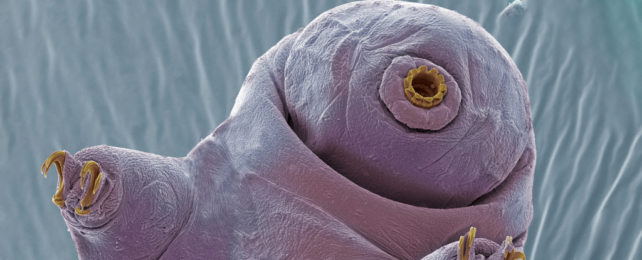Reminiscent of the title character in the classic fairy tale Sleeping Beauty, famously tough tardigrades can pause their biological clocks when in a deep, cold sleep, new research suggests.
These ridiculously hardy beasties already have a variety of superpowers they use to withstand the harshest of conditions, including armor to protect their all important DNA from radiation and a special protein padding that keeps their cells from collapsing during long periods of dehydration.
With this bag of tricks and more they can even survive the vacuum of space.
To withstand freezing to death the cuddly-looking water bears enter an extreme form of hibernation called cryobiosis. In this state their metabolic activity basically comes to a standstill.
It now turns out their metabolism isn't the only process set to 'pause'.
University of Stuttgart biologist Jessica Sieger and colleagues exposed a bunch of Milnesium inceptum tardigrades to alternating weekly periods of freezing at −30 °C (−22 °F) and feeding at 20 °C (68 °F), until they died. Another group was maintained at room temperature.
Amazingly, out of a total of 716 tardigrades, those that were periodically frozen lived twice as long as the control group. The longest lived for 169 days, 94 of those spent at room temperature, while the oldest tardigrade in the control group reached 93 days.
All up, both groups spent the same amount of time actively alive, demonstrating that the tardigrade's biological aging was dramatically slowed, if not halted altogether by cryobiosis. This, the researchers say, confirms the 'sleeping beauty' model of cryobiosis on the animal's biological clock, as opposed to other models that suggested aging is either slowed or continues as normal.
"During inactive periods, the internal clock stops and only resumes running once the organism is reactivated," explains zoologist Ralph Schill, also from the University of Stuttgart. "So, tardigrades, which usually only live for a few months without periods of rest, can live for many years or even decades."
These adorable near-immortals also go into a suspended animation state under extremely dry conditions – a process called anhydrobiosis. Previous research from Schill has demonstrated that tardigrades suspend their aging during this state too, but this is the first time it's also been confirmed while in a frozen condition.
This nifty little trick allows the millimeter-sized beasties to wait out hazardous conditions and spring back into action once their surroundings are more favorable. For example, the return of rain after decades of drought, in place of the true loves' kiss that woke Sleeping Beauty.
Tardigrades have been recovered after being frozen for more than 30 years, still alive and fertile. But their suspended animation is not a foolproof system.
Freezing safely is a complicated physiological process. Death can occur instead, if freezing happens too fast – not allowing certain biochemical processes to complete quickly enough, the researchers explain.
Insufficient energy storage can be another factor that can go very wrong. Previous studies have demonstrated that entering and exiting their profound sleep state uses the energy stored in cells within the body cavity of the chonky animals.
"The severity, seasonality, unpredictability and variability of environmental conditions determine the life cycle patterns of invertebrates," Sieger, Schill and team summarize in their paper.
This research was published in the Journal of Zoology.
